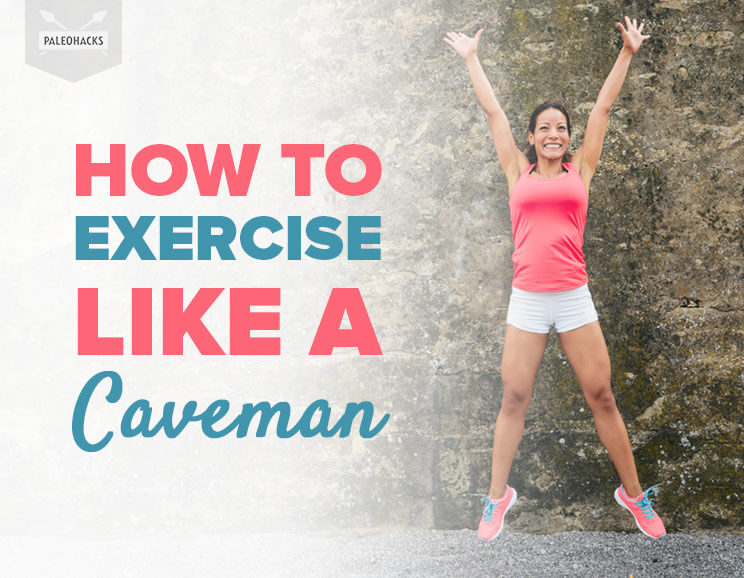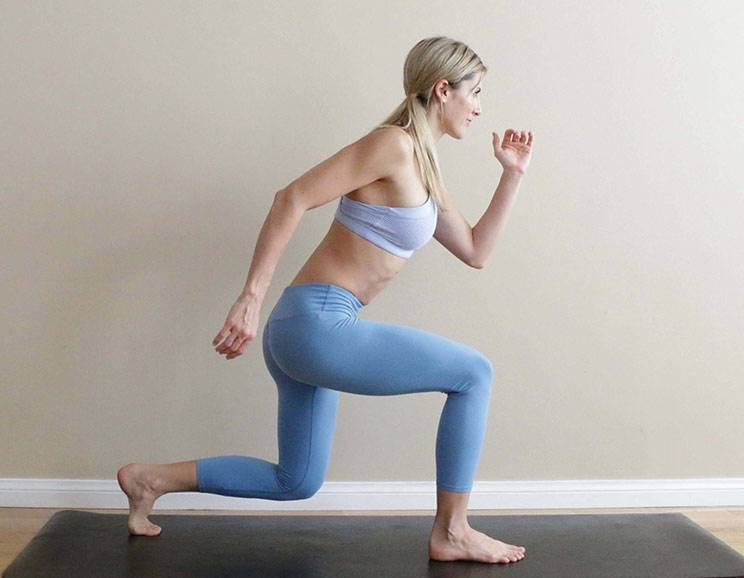Exercise is just as important as eating well. Here’s how to exercise like a caveman when you’re already eating like one!
But what did our primal ancestors do for exercise? Well, exercise for them wasn’t anything they had to think about. It was life. Everyday meant moving and exercising to gather food, build shelter, or simply to survive.
A Paleo exercise program is one that is similar to what our ancestors did. Follow these simple rules to find ways to incorporate Primal Workouts into your lifestyle and exercise like a caveman.
Looking for an easy way to get started working out?
Grab our FREE Beginners Workout Guide – 3 Weeks To Tighter Abs, Sculpted Arms, And Toned Legs, by clicking here!
Rule 1: Move a lot at a Slow Pace
Cavemen spent much of their day walking around hunting and gathering their food, and wandering and migrating to new territories. Take one out of their book and move around as much as possible during your day. Low aerobic level throughout the day will build strong blood vessels, bones, joints, and connective tissues.
Easy ways to incorporate low aerobic activity could be walking or riding your bike to work if possible. Park your car as far away from your destination as possible and walk the rest of the way. Take the stairs instead of the elevator. While at work, take frequent breaks to get up and walk around, or use your lunch break to head outside for a walk.
Always walk down to a coworkers office instead of sending an email. You may even want to try a standing or treadmill desk if possible. On weekends or after work, try hiking or go swimming. Somehow stay active every day in someway, even on your “rest days.”
Rule 2: Sprint Every so Often
Our Paleo ancestors didn’t spend hours and hours exercising, and neither should you. In the Paleolithic era, life depended on being able to outrun animals, either in the form of hunting them or to avoid being hunted by them. They would only work hard when they needed to. Practice some High Intensity Interval Workouts (HIIT).
These can include running sprints, biking sprints, or swimming sprints. When sprinting, it’s important to remember this should be all out effort, catch your breath for a minute or two between sets, and then repeat. You only need to complete 5-8 sets, once or twice a week, to benefit cardiovascularly from sprints.
Rule 3: Lift Heavy Things
Just like sprinting, cavemen had to use quick bursts of energy to lift and move heavy objects. They would have to move large rocks or logs to build shelter, carry firewood or large animals back to their homes. These type of high intensity workouts help release testosterone that boosts metabolism and improves muscle strength and size.
The best movements for heavy lifting are full body exercises like squatting, lunging, and deadlifting, pull ups, and push ups. These primitive movements are natural and functional exercises that have been around since the cavemen themselves.
Types of Primal Workouts to Try
Crossfit
Using Crossfit and the Paleo diet together is very common. This is because Crossfit uses many of the primal exercise practices mentioned above. Crossfit is based on high intensity, functional movements that build strength and endurance.
Body Weight Workouts
Many bodyweight exercises like crawling or climbing a rope can’t be replicated by lifting weights. These exercises require activation of more muscles than weight machines alone.
Bodyweight exercises, such as a push up, require more core strength and stability muscles than it’s counterpart, the bench press. Bodyweight exercises such as plyometrics can also greatly increase cardiovascular fitness and can be used as your sprints.
Animal Flow
This relatively new style of exercise is based on the movements of various types of animals. These quadrupedal and ground based movements flow from one to the next using multiple planes of motion.
Each movement increases mobility, flexibility, stability, power, and strength through the shoulders, core, and legs. Animal flow connect your mind to you body also increasing neuromuscular awareness and communication. 
Primal Bodyweight Workout
Try this fusion of bodyweight exercises and Animal Flow exercises to get a great Paleo workout in that requires no equipment.
-
- Bear Crawl – Start on all fours, keeping your abs tight, and lift your hips slightly to raise your knees off the floor. Step forward with right hand and right foot, and then immediately do the same with the left side. Crawl forward taking about 10 ‘steps’ and then reverse, completing 3-5 sets total.
-
- Scorpion Reach – Bring yourself into a downward facing dog position and lift your RIGHT leg up, bending your knees to 90 degrees and opening your hips to the RIGHT. Shift your weight as far forward, bringing your RIGHT knee towards your LEFT elbow. Bring your leg back up to ceiling and repeat 10 times and then repeat on the other leg.
-
- Vertical Frog Jump – Start with your feet slightly wider than shoulder width apart and your knees and toes turned out. Lower into a deep squat reaching your hands to the floor between your feet. Jump as high as you can and extend your arms overhead. Land softly in the squat, with hands to the floor, and repeat 10-15 times.
-
- Donkey Kicks – Start in a crouch position, with your hands directly under your shoulders and your abs pulled tight. Quickly kick your legs up into the air bending your knees and bringing your heels towards your glutes. Land softly and repeat 10 times.
-
- Beast Reach – Start in a crouch position, reaching your arms forward as far as you can. Shift your weight forwards, straightening your legs into a plank position, bringing your RIGHT knees to the outside of your RIGHT elbow. Return back to the crouch position and repeat on the other side. Complete 12 repetitions total.
-
- Spider Push Ups – Start in a plank position and as you lower into a push up, lift your RIGHT foot off the floor, bringing your knee to the outside of your RIGHT elbow. Reach your foot back as you push up into a plank position. Repeat on the LEFT side and complete 12-20 repetitions total.
(Your Next Workout: 10 Classic Bodyweight Exercises: From Easy to Advanced)



 Advanced Glycation End-Products (AGEs): The Root of Inflammation, Disease, and Aging
Advanced Glycation End-Products (AGEs): The Root of Inflammation, Disease, and Aging






Show Comments